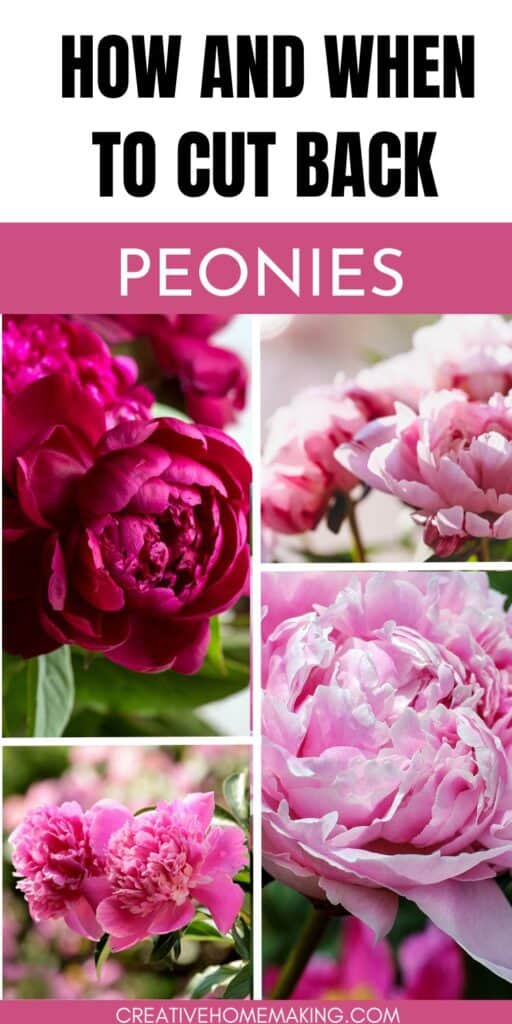Are you wondering when the best time is to cut back your peonies? As a peony enthusiast, you want to ensure that your plants remain healthy and vibrant year after year. Knowing when to cut back your peonies is essential to their growth and longevity.
This post may contain affiliate links.
Peonies are hardy perennials that require specific care to thrive. Cutting back your peonies at the right time can promote healthy growth and ensure that your plants bloom beautifully year after year.
In this article, we will explore the best time to cut back your peonies and provide tips on how to care for them throughout the year.
Related Article: When to Cut Back Lilacs: Tips and Tricks for Pruning Success
Understanding Peonies
Peonies are a beautiful and popular flower that come in a variety of types. They are a perennial flower, meaning they come back year after year. Understanding the different types of peonies can help you know when to cut them back and care for them properly.
Related Article: How to Cut Back Rosemary
Types of Peonies
There are four main types of peonies: tree peonies, herbaceous peonies, intersectional peonies, and Itoh peonies. Tree peonies are woody shrubs that bloom earlier than other peonies and have large, showy flowers.
Herbaceous peonies are the most common type and have soft stems that die back in the winter. Intersectional peonies are a cross between tree and herbaceous peonies, and have the best traits of both.
Itoh peonies are a newer variety that are a cross between tree and herbaceous peonies, and have large, colorful flowers.
When to Cut Back Peonies
Knowing when to cut back your peonies is important for their health and growth. The best time to cut back herbaceous peonies is in the fall after the first frost, when the leaves have turned yellow.
Cut the stems down to about 2 inches above the ground. Tree and intersectional peonies should not be cut back, but dead or damaged wood can be pruned in the fall or spring. Itoh peonies should be cut back in the fall after the leaves have turned yellow, similar to herbaceous peonies.
Related Article: When to Cut Back Azaleas for Optimal Growth and Blooming
Caring for Peonies
Peonies prefer well-drained soil and full sun, but can tolerate some shade. They should be watered deeply once a week, especially during hot, dry weather.
Fertilize in the spring with a balanced fertilizer, and mulch around the base of the plant to retain moisture and control weeds. Avoid planting peonies too deep, as this can inhibit blooming.
In summary, understanding the different types of peonies and when to cut them back is important for their health and growth.
Care for your peonies by providing well-drained soil, full sun, and regular watering and fertilizing. With proper care, your peonies will provide beautiful blooms year after year.
Related Article: Worst Time to Prune Trees: When You Should Avoid Trimming Your Trees
Why Cut Back Peonies
Cutting back your peonies at the right time is essential for maintaining their health and promoting healthy growth. Here are a few reasons why you should cut back your peonies:
Promotes Health
Cutting back peonies helps to remove any dead or diseased foliage from the plant. This helps to promote overall plant health and prevent the spread of disease. By removing dead foliage, you also decrease the chances of pests and insects from infesting your peonies.
Related Article: Do Hydrangeas Need to Be Cut Back for Winter? A Gardener’s Guide
Increases Energy
Cutting back your peonies can help to increase their energy levels. By removing the dead foliage, your peonies can focus their energy on new growth rather than trying to maintain old, dead foliage. This can lead to larger, more vibrant blooms.
Encourages Bloom
Peonies that are not cut back may produce fewer blooms or smaller blooms. By cutting back your peonies, you encourage them to produce more blooms and larger flowers.
This is because cutting back stimulates the plant to produce more lateral buds, which can lead to a second round of blooms.
Promotes Large Flowers
Peonies that are not cut back may produce smaller flowers. By cutting back your peonies, you encourage the plant to produce larger flowers. This is because cutting back stimulates the plant to produce more energy and nutrients, which can lead to larger flowers.
Related Article: When to Cut the Flowers off Your Hydrangea: A Quick Guide
Encourages Second Round of Blooms
Cutting back your peonies can lead to a second round of blooms. This is because cutting back stimulates the plant to produce more lateral buds, which can lead to a second round of blooms. This can extend the blooming season and provide you with more beautiful flowers to enjoy.
Overall Health
Cutting back your peonies is essential for maintaining their overall health. By removing dead foliage and promoting healthy growth, you can ensure that your peonies continue to thrive year after year.
When to Cut Back Peonies
Peonies are a popular perennial flower that can add beauty and color to your garden. Cutting back your peonies at the right time is essential to ensure they stay healthy and produce beautiful blooms year after year. Here’s what you need to know about when to cut back your peonies.
Related Article: How to Divide Daylilies
In the Fall
In the fall, after the first frost, you should cut back the foliage of your peonies to about 2-3 inches above the ground. This will help prevent any diseases from overwintering in the old foliage and also allows the plant to conserve energy for the next growing season.
In the Winter
During the winter, you don’t need to do anything special to your peonies. They will go dormant and come back in the spring.
Related Article: When to Separate Peonies: A Gardener’s Guide
In the Early Spring
In the early spring, you should remove any dead or damaged stems from your peonies. This will help promote healthy growth and prevent any diseases from spreading.
Related Article: Can I Prune Lilacs in October? Tips for Proper Lilac Pruning
Late September
Late September is a good time to start preparing your peonies for the winter. You can cut back any dead foliage and remove any weeds or debris from around the base of the plant.
During the Growing Season
During the growing season, you don’t need to cut back your peonies. They will grow and bloom naturally, and you can enjoy their beautiful flowers.
Remember, cutting back your peonies at the right time is essential to their health and success. By following these tips, you can ensure that your peonies will continue to thrive and produce beautiful blooms year after year.
Related Article: When to Cut Strawberry Runners from the Mother Plant: A Guide
How to Cut Back Peonies
Cutting back peonies is an important task that ensures healthy growth and blooming for the next season. Pruning peonies is not difficult, but it requires some care and attention to detail. Here are some steps to follow when cutting back your peonies:
- Timing: The best time to cut back peonies is after the first frost in the fall or early winter. This is because the plant has gone dormant and the foliage has died back, making it easier to see the stems and buds.
- Tools: You will need a pair of sharp pruners or garden shears to cut back the stems. Make sure the blades are clean and sharp to prevent damage to the plant.
- Cut back to the ground: Using your pruners, cut back the stems to ground level. Make sure to cut at an angle to prevent water from pooling on the cut surface.
- Remove dead foliage: After cutting back the stems, remove any dead foliage from around the base of the plant. This will help prevent disease and pests from overwintering in the debris.
- Dispose of debris: Dispose of the debris in a compost pile or trash bin. Do not leave it on the ground as it can attract pests and disease.
Related Article: Transplanting Peonies in Spring: A Quick Guide
Dealing with Peony Blooms
When it comes to peonies, the blooms are the star of the show. However, as the blooms start to fade and wilt, you may be wondering what to do next. Here’s what you need to know about dealing with peony blooms:
Deadheading Peonies
Deadheading is the process of removing spent flowers from a plant. This encourages the plant to focus its energy on producing new blooms instead of producing seeds. Deadheading peonies is a simple process that can be done by hand.
To deadhead a peony, wait until the blooms have started to fade and wilt. Then, use a pair of sharp scissors or pruning shears to cut the stem just below the spent flower. Be sure to cut at an angle to prevent water from pooling on the cut surface.
Removing Dead Peony Blooms
If you missed the opportunity to deadhead your peonies and the blooms have already died, don’t worry. You can still remove the dead blooms to keep your plant looking tidy.
To remove dead peony blooms, use the same process as deadheading. Cut the stem just below the dead flower, making sure to cut at an angle.
Dealing with Flower Buds
Peonies typically produce multiple flower buds on each stem. If you want to encourage your plant to produce larger blooms, you can remove some of the smaller buds.
To do this, wait until the buds have started to develop but haven’t yet opened. Then, use your fingers or a pair of scissors to remove the smaller buds, leaving only the largest buds on the stem.
Maintaining Peony Health
Peonies are a beautiful addition to any garden, but they require some maintenance to keep them healthy and looking their best. Here are some tips on maintaining peony health:
Removing Dead Stems and Foliage
It is important to remove dead stems and foliage from your peony plants regularly. This will help prevent the spread of diseases and pests. Cut back any dead stems to the ground level and remove any unsightly foliage. This will also promote new growth and keep your plant healthy.
Pruning Needs
Peonies require pruning to maintain their shape and promote healthy growth. Prune any diseased branches or woody stems to prevent the spread of fungal diseases such as powdery mildew and botrytis blight. Cut back any seed heads to promote new growth and maintain plant health.
Pest and Disease Control
Peonies can be susceptible to pests and diseases, so it is important to keep an eye out for any signs of trouble.
Look for signs of fungal diseases such as powdery mildew and botrytis blight, and treat them promptly with a fungicide. Keep an eye out for pests such as aphids and spider mites, and use insecticides as needed.
Maintaining Peony Flowers
Peony flowers are beautiful, but they require some maintenance to keep them looking their best. Remove any dead or diseased buds to promote healthy growth and prevent the spread of diseases. Cut back any unsightly foliage around the flowers to promote their beauty and keep them healthy.
By following these tips, you can keep your peonies healthy and looking their best. Regular maintenance is key to maintaining plant health and preventing the spread of diseases and pests.
Preventing and Treating Diseases and Pests
Peonies are generally hardy and disease-resistant, but pests and diseases can still occur. Here are some tips to prevent and treat them:
- Compost: Use compost to enrich the soil and improve drainage. Healthy soil means healthy plants, which are less likely to be affected by diseases and pests.
- Insects: Keep an eye out for insects such as aphids, thrips, and spider mites. If you spot any, spray them with insecticidal soap or neem oil.
- Perennials: Plant peonies with other perennials to create a diverse ecosystem that attracts beneficial insects and pollinators.
- Autumn: In the autumn, cut back the foliage to ground level and dispose of it. This will prevent any diseases from overwintering in the plant.
- Mulch: Mulch around the plant with shredded bark, pine needles, or compost. This will help retain moisture and suppress weeds.
- Cutting back peonies: Cut back the stems to ground level in the fall after the first frost. This will help prevent any diseases from overwintering in the plant.
- Suckers: Remove any suckers that grow from the base of the plant. These can sap energy from the main plant and increase the risk of disease.
- Winterize: In the winter, cover the plant with a layer of mulch or straw to protect it from the cold.
By following these tips, you can keep your garden peonies healthy, golden, and neat and tidy. And by adding the foliage to your compost pile, you can create a nutrient-rich soil amendment for your garden.
Gardening Tips for Peonies
Peonies are beautiful, long-lived perennials that can add a splash of color to any garden. If you’re growing peonies, it’s important to know when and how to cut them back to ensure that they continue to thrive year after year.
During the growing season, peonies rely on photosynthesis to produce energy and grow. To ensure that your peonies are healthy and strong, it’s important to let them photosynthesize as much as possible. This means that you should avoid cutting back the foliage until it has turned completely brown.
Once the foliage has turned brown, it’s time to cut back your peonies. Use a pair of sharp pruning shears to cut the stems down to ground level. Be sure to clean your pruning shears with rubbing alcohol before and after using them to prevent the spread of disease.
When cutting back your peonies, it’s important to keep in mind the climate in your area. If you live in a colder climate, you may need to cut back your peonies earlier to prevent damage from frost.
On the other hand, if you live in a warmer climate, you may be able to wait a bit longer before cutting back your peonies.
Frequently Asked Questions
Can peonies be cut back in the summer?
Yes, you can cut back peonies in the summer, but it’s not recommended. Cutting back peonies during the summer can result in fewer flowers the following year. It’s best to wait until the fall to cut back peonies.
Should peony flowers be cut?
If you want to enjoy the beauty of peony flowers, you should leave them on the plant. However, if you want to cut peony flowers for arrangements, you should cut them when they are in bud form and just starting to open. This will help the flowers last longer in the vase.
Do peonies die back in the summer?
Peonies do not die back in the summer, but their foliage may turn yellow and brown. This is a normal part of the plant’s growth cycle. The foliage will continue to provide nutrients to the plant until it dies back in the fall.
Does cutting peonies encourage more flowers?
Cutting peonies does not necessarily encourage more flowers. However, removing spent flowers can help redirect the plant’s energy to producing more blooms.
When to cut back peonies in the fall?
You should cut back peonies in the fall after the first frost. This is usually in late September or early October. Cut the foliage back to about 3 inches above the ground.
What happens if you don’t cut back peonies?
If you don’t cut back peonies, the dead foliage will remain on the plant throughout the winter. This can provide a hiding place for pests and diseases. Additionally, leaving the foliage on the plant can result in a messy appearance in the garden.




